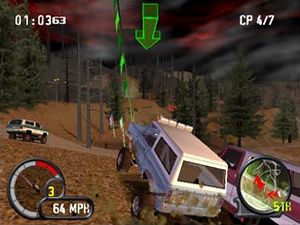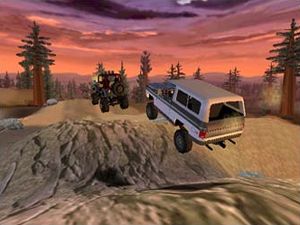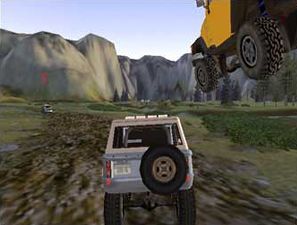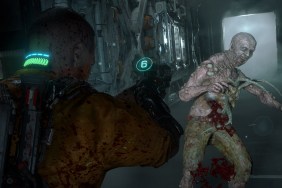Offroad? Yes. Off the mark? Slightly.
The PS2 isn’t just a baby in messy diapers anymore. It’s nearly a year old
now and getting to be a big boy. It’s still scared of the dark and can’t tie
it’s own shoes but it’s about time it got a chance to start acting its age and
show us what it can do, give us doting gamers the opportunity to see it taking
on a consistent stream of games that are more interesting, more involving and
offer more variety than what the PSOne has to offer. Even a dismal series like
Test Drive: Off Road should
be able to redeem itself with the PS2’s technology and burgeoning adolescence.
The latest in the series, Test Drive Off Road Wide Open, makes
a valiant effort to distance itself from its dysfunctional family of origin.
Though a mixed bag of tricks, its attempts are greeted with a modicum of success.
The object is to maneuver your off-road vehicle through numerous checkpoints
spread throughout huge areas. For your driving pleasure you have your choice
of boxy, poorly-rendered trucks, jeeps, and SUVs. All of them have engines that
sound like old weed whackers and kitchen appliances in desperate need of 3-in1
Oil.
In Career Mode you purchase your off-roader, pay to race and use your winnings
to buy upgrades or other vehicles. Upgrades (which, for some asinine reason,
must be unlocked) result in a three-stage de-dorkification of your ride. It
will no longer resemble a Tonka toy, school bus or the Mystery Machine quite
so closely. There will be noticeable differences in handling, speed, acceleration
and braking.
Players eventually get to select Modified, Pro or Unlimited upgrades, but you
won’t find yourself tweaking your own vehicle to suit your individual style.
In fact, there are no customizing options other than a limited palette of colors
to choose from. This works out great for the very young and others who haven’t
gotten the hang of making their own decisions. For the rest of us it merely
makes the game flat and largely uninvolving.
Vehicles are divided into two classes – those with speed and those with power.
Power vehicles like the Jeep CJ5 and the Chevy Blazer are better for climbing
steep terrain and handle easier for hitting checkpoints. Speedsters like the
Dodge Ram 2500 and the Hummer Wagon can mack on straightaways but can easily
sail right past a checkpoint.
It is in the area of physics and suspension where TDORWO distinguishes
itself from the fairly lackluster crop of PS2 games out there. The physics are
truly impressive. Vehicles have weight without being awkward and sluggish. They
can fish tail, spin out, flip over and slam into objects and other vehicles.
You really do get the illusion of speed as you zip along straight passes or
fly downhill. Driving these things is a sheer joy.
However, the game falls short in the damage modeling, as there is none to speak
of. No matter how many times you smack into boulders or how fast you were going
when you impacted, you won’t notice more than a little mud spatter when the
race is done.
Races take place within three different ecosystems – Utah, Yosemite and Hawaii.
Environments are huge, wide open and extremely well designed. Though some of
the overlaying textures are dull, the enormity of the environments and the variety
of terrain will make you sit up and take notice.
 Keep
Keep
in mind that TDORWO is a checkpoint racer – the kind in which you can
flawlessly fly ahead of the pack for your first several laps, then miss a checkpoint
by a millimeter and watch tearfully as your opponents flood past while you attempt
a couple of impromptu U-turns. This is a slight annoyance on the Circuit and
Blitz tracks. The Scramble tracks, though, have checkpoints which can be hit
in any order, so in addition to the slightly-missed checkpoint factor you will
have the added frustration of not knowing where you’re going. These random checkpoints
render your navigation arrow practically useless as it will have you coaxing
your Jeep Wrangler up the side of Mount Everest to reach a checkpoint.
Onscreen advice suggests studying your relatively featureless map or following
your opponents in order to find the most expedient route. This is fine until
you lose or overtake them (it’s a race, remember?) and then quickly ascertain
that you have no clue where you’re headed.
Some vehicles drive with amazing aggression. They will knock you to the side
before reaching a checkpoint or go so far as to turn you in the opposite direction.
These drivers are downright malicious and appear to make a concerted effort
to assure that you have more than your fair share of trouble on the road. This
adds significantly to the experience, although it will make you wonder how your
Dodge Durango has the traction to climb a near vertical incline but can’t withstand
a side-swipe by a little Jeep with road rage.
TDORWO offers players a lame replay feature where you will find yourself
observing a completed race from the same perspectives available when you were
driving – chase cam, first person and rear view. If you were paying attention
when you were racing, you saw that already. They missed an excellent opportunity
to win players over by letting us see for ourselves just how crazy the race
really was.
But in the end, TDORWO is a lot of fun for a couple of hours and makes
a more than worthy rental. Excellent physics and suspension, aggressive opponents,
and humongous and well-planned out environments give a bit of shine to a game
that is otherwise strictly last generation.

-
Excellent physics
-
Huge environments
-
Aggressive drivers
-
Fun for a few hours
-
Flat textures
-
No customization







